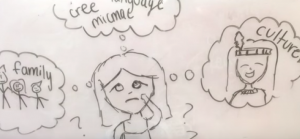- Incorporating digital media into our classrooms can help Aboriginal Legends come to life. Using a QR code, teachers can help to safely guide students to specific stories and legends without lengthy web searches. Using a QR code reader, such as Qrafter, scan the below bar code. You will be immediately directed to open up the URL and there will be Grandmother Spider Brings The Sun. This is the narration of the book by the same name by Navajo author Geri Kearns. ( You can get to it through this link too, but have fun and try the code!)
 https://www.youtube.com/watch?v=ok_b46A9hvE
https://www.youtube.com/watch?v=ok_b46A9hvE
2. http://honeyant.com.au/aboriginal-education/
This was an interesting website to come upon. Please take the opportunity on the site to listen to this interview by Margaret James. She talks about children coming into school with Aboriginal English, which is what I have been writing about in my paper; we call it English as a Second Dialect here in BC (ESD). She emphasizes that students need to learn to read in their first language, then will transfer the skills. These books will be not focusing on the gender or pluralizing of words. I am curious to get my hands on one to take a look.
3. https://www.youtube.com/watch?v=HbccTPEgBhs
I am so pleased to have found the work of Dr. Pamela Rose Toulouse. This video is called How Can Literacy Be Fostered in Aboriginal Kids? She reveals the research that no matter the mother language of the student, English or French will be their second dialect. The child has picked up nuances embedded in their language and bring these to the classroom. These differences need to be valued, even if standard English is the goal. This can be confusing for the child when taught with an emphasis on gender, punctuation etc. The students really have to be “bi-dialectical”, that is having the ability to function in 2 worlds. A variety of resources and exemplars in the classroom will help to create a positive learning environment.
http://elevatorstrategy.com/blog/2015/20-awesome-aboriginal-twitter-accounts-to-follow/
If you want to get connected on Twitter and become more informed about the issues of importance for Aboriginal people, check out this link. You can follow groups such as @Reconciliation Canada or @IENearth, a group of Indigenous people fighting for environmental justice or follow individuals such as @UrbanNativeGirl, From the Tsilhqot’in Nation, Lisa Charleyboy is the Editor for Urban Native Magazine. She’s a well known thought leader in the Aboriginal community and keeps up to date on events and news.
5. Indigenous Education in Canada PSA. In the below video,a 17 year old Indigenous youth in Nunavut talks about her history. She reflects on  the 51% drop out rate and the importance of heritage and culture being taught in the schools as part of change. Encouraging more Aboriginal People to go into the field of education would support our children in their schools. Relationships between educators and Aboriginal Peoples must be strengthened as language and culture comes into the classroom, with an emphasis on the importance of this for all students. https://www.youtube.com/watch?v=ZrUw1WYfZXc
the 51% drop out rate and the importance of heritage and culture being taught in the schools as part of change. Encouraging more Aboriginal People to go into the field of education would support our children in their schools. Relationships between educators and Aboriginal Peoples must be strengthened as language and culture comes into the classroom, with an emphasis on the importance of this for all students. https://www.youtube.com/watch?v=ZrUw1WYfZXc

